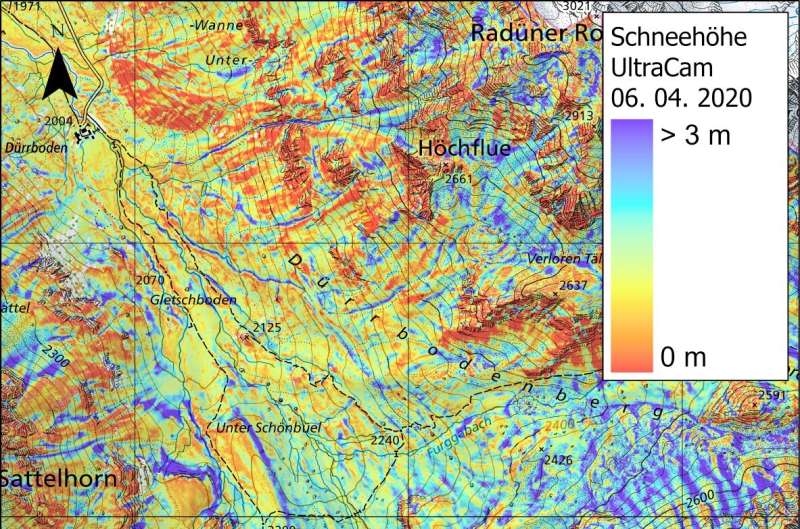
You don’t always need a laser—sometimes a camera will do. Researchers at the WSL Institute for Snow and Avalanche Research (SLF) have now disproved the paradigm that the height of snowpack can only be accurately determined from the air using laser scanners, says Yves Bühler, Head of the SLF’s Alpine Remote Sensing research group.
“We were surprised ourselves that we were able to map snow so accurately using photos taken from a plane at very high resolution.” The method is known as photogrammetry. The scientists mapped the snowpack across an area of approximately 250 square kilometers around Davos, from Klosters in the north to Piz Fourun in the south, with the Dischma Valley in the center. The resolution was half a meter and the accuracy 15 centimeters, as shown by a comparison with measurements taken by hand and from drones.
Accurate snow data is an important resource for predicting natural hazards such as avalanches and floods, as well as determining the snow load on roofs. Energy suppliers can also make use of such results. “Our data helps to improve models that show how much water there is in the snowpack,” explains Bühler. This, he says, is important for the operation of hydropower plants. Researchers can also use the information to determine suitable locations for weather stations, whose measurement results they then extrapolate for the entire area.
Another advantage of the method is that it saves money. For photogrammetry, aircraft operate at an altitude of around 6,000 meters, says Bühler. “With laser scanners, they have to fly much lower and slower.” Other approaches also have their drawbacks. Drones are only suitable for small areas of four to five square kilometers, and satellite data is not yet accurate enough.
The SLF now has comprehensive snow depths for the study area from 2010 until today, forming an unparalleled long-term data set. The images were taken by Flotron, an engineering firm, on behalf of the SLF in late March and early April, the time of year when the snow at higher elevations in the Davos region is at its maximum depth.
The planes were equipped with surveying cameras. “Essentially, these are conventional cameras, only with an extremely high resolution of 450 megapixels instead of the 24 megapixels found in standard devices,” explains Bühler. The next step for the researchers is to subtract the heights indicated on a snow-free surface model from those on a surface model with snow cover. The difference is the snow depth.
The measurements show that the snow depth varies from year to year, but this only applies to the absolute values. “In relative terms, the ratio of snow depth from point to point is usually very similar over the years,” says Bühler. There are exceptions, though, with snow depths differing significantly between years in some cases. He cites avalanches and snow transport as possible reasons. These differences are exciting for avalanche research, and the data from Bühler’s team now enables them to be analyzed in detail.
The SLF will undertake further flights in Davos in the coming winters to continue this unique time series. The results obtained so far are already being used by many projects, for example to validate model calculations for the whole of Switzerland, says Bühler. “We’ve also already received enquiries about measuring snow depth over large areas in other regions using this method.”
The research is published in The Cryosphere.
More information:
Leon J. Bührle et al, Spatially continuous snow depth mapping by airplane photogrammetry for annual peak of winter from 2017 to 2021, The Cryosphere (2022). DOI: 10.5194/tc-2022-65
Journal information:
The Cryosphere
Provided by
Schnee und Landschaft WSL
From aerial photograph to precise snow depth (2023, August 18)
retrieved 27 September 2023
from https://phys.org/news/2023-08-aerial-precise-depth.html
part may be reproduced without the written permission. The content is provided for information purposes only.